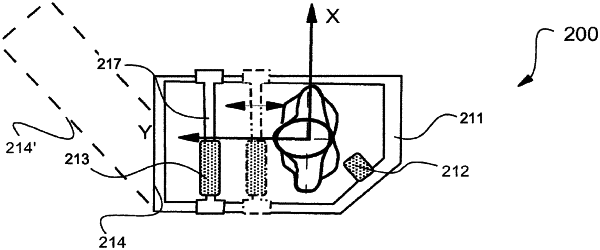| CPC A61H 1/0292 (2013.01) [A61H 2203/0406 (2013.01); A61H 2203/0475 (2013.01)] | 20 Claims |

|
1. A method for treating scoliosis, comprising:
having a lumbo pelvic derotator that includes:
a frame having a first rigid end member, a second rigid end member, a first rigid side member connected between the first rigid end member and the second rigid end member, and a second rigid side member connected between the first rigid end member and the second rigid end member, wherein the first rigid end member, the second rigid end member, the first rigid side member, and the second rigid side member are disposed in a coplanar relationship within an x-y reference plane of a Cartesian coordinate system defined by an x reference direction and a y reference direction, wherein the first rigid end member, the second rigid end member, the first rigid side member, and the second rigid side member collectively circumscribe an area within the x-y reference plane, wherein the area is sized to enable a person to stand within the area when fitted with the lumbo pelvic derotator with the first rigid end member extending across an anterior side of the person and with the second rigid end member extending across a posterior side of the person, wherein a portion of the first rigid end member extends substantially parallel to the x reference direction, and wherein an angled portion of the second rigid end member extends in a direction that is not parallel to the x reference direction, wherein a first distance along the first rigid side member as measured between the first rigid end member and the second rigid end member is less than a second distance along the second rigid side member as measured between the first rigid end member and the second rigid end member,
a first padding member disposed on the first rigid end member,
a second padding member disposed on the angled portion of the second rigid end member, and
an armature connected to both the first rigid side member and the second rigid side member at a location in the y reference direction spaced apart from the first rigid end member, such that a distance between the armature and the second rigid end member is greater than a distance between the armature and the first rigid end member, wherein the armature is shaped to drive the second rigid end member in a rotational direction about the first rigid end member in response to application of a downward force to the armature;
fitting the lumbo pelvic derotator to the person such that the person is standing within the area circumscribed by the first rigid end member, the second rigid end member, the first rigid side member, and the second rigid side member, with the first padding member positioned against an anterior side of the person and with the second padding member positioned against a posterior side of the person; and
applying a downward force to the armature to drive the second rigid end member in a rotational direction about the first rigid end member such that the second padding member applies a derotational force to a thoracolumbar spinal portion of the person.
|